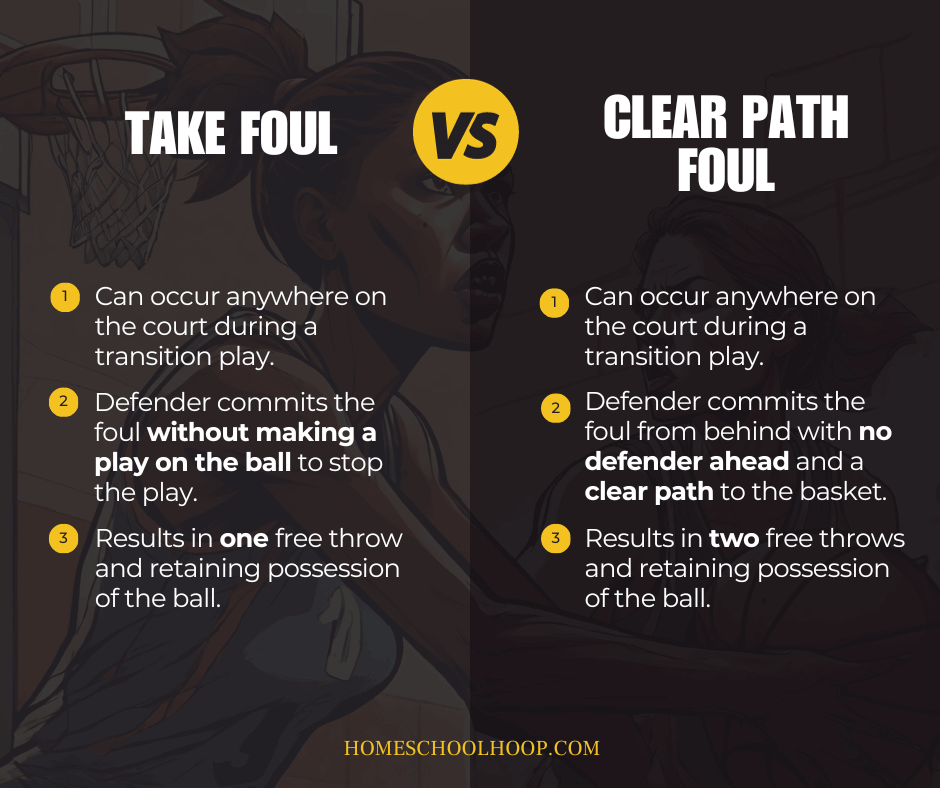Both the NBA (National Basketball Association) and WNBA (Women’s National Basketball Association) have introduced a rule known as the “transition take foul” to make the game even more exciting by promoting fast-paced plays. But what exactly does this mean?
Key Takeaways:
- Let’s say that one team is about to score easily on a fast break, but a player from the other team stops this by fouling. This intentional foul without trying to play the ball is a transition take foul.
- The NBA and WNBA upgraded the penalty for transition take fouls to keep the game flowing.
- There is a take foul exception in the final two minutes of games.
If you’re getting into basketball or have been a fan for years, understanding the transition take foul helps you better grasp the game’s strategy. This rule shapes how defense is played in men’s and women’s basketball. Let’s dive deeper into what a transition take foul is, its significance, and how it’s reshaping the game.
Definition and Mechanics of a Take Foul
A transition take foul, also known as a take foul, is essentially an intentional foul made by a defensive player to stall a fast break.
A take foul in basketball occurs during a transition play or immediately following a change of possession, typically when the offensive team has a clear advantage, such as during a fast break.
The defender commits the foul without making a play on the ball to stop the play, preventing an easy score.
Examples of Transition Take Fouls
To better understand transition take fouls, let’s look at some specific scenarios where this foul would be typically called in a game.
- A team gains possession after a defensive rebound and quickly transitions down the court into a fast break. A defender, realizing they’re not in a good position to block or steal legally, intentionally grabs the jersey of the player with the ball.
- Off a missed free throw, the offense has an advantageous 3-on-2 against the defense. A defender wraps up an offensive player without the ball to stop play.
- A star player intercepts a pass and heads for a fast break. Before the star player can pass the ball ahead, a defender on the opposing team opts to foul them to prevent the play.
There are many different circumstances in which a transition take foul can be called. It’s any time there’s an attempt to wrap up the ball handler or grab an opponent to prevent them from entering a fastbreak.
How is the Take Foul Enforced?

Historically, take fouls were treated like regular basketball fouls. The fouled team would get possession of the ball but without additional penalties. This lack of severe consequences made take fouls a common defensive strategy to disrupt fast breaks.
That’s no longer the case. The NBA and WNBA have since upgraded the penalties for transition take fouls.
Now, if refs make a transition take foul call:
- The offensive team is rewarded one free throw that any player on the court can shoot.
- Plus, the offensive team retains possession of the ball.
The evolution of this rule reflects the leagues’ efforts to maintain the fast-paced and uninterrupted flow of the game. It means less lazy defense, more NBA and WNBA dunks, and other exciting free-flowing transition plays.
Exceptions to the Take Foul Rule
The take foul rule in the NBA and WNBA is straightforward, but there is an exception during endgame scenarios:
The take foul rule is not enforced in the final two minutes of the fourth quarter and the last two minutes of overtime periods.
This exception allows teams to intentionally foul at the end of games to stop the clock in their comeback attempt.
Take Foul vs. Clear Path Foul

Take fouls are often confused with clear path fouls. While the two occur during a transition play, they differ in definition and penalties.
- A take foul can occur anywhere on the court during a transition play, resulting in one free throw and ball possession for the fouled team.
- A clear path foul requires a specific transition scenario — no defender ahead, and the offense has a clear path to the basket. The penalty is more severe: two free throws (instead of one) and possession.
Learn more: How many players are on a basketball team?
The Rise and Impact of Take Fouls in Basketball
The concept of the take foul, initially termed the Euro foul, originated in European basketball leagues. The strategy was to foul during a transition play to stop a fast break, giving the defending team time to reset and preventing an easy basket.
This tactic gained popularity in the NBA and WNBA as teams recognized giving up a foul rather than an easy two points was better. It became a common defensive strategy to prevent easy scoring opportunities. However, it also led to more interruptions, impacting the game’s flow and excitement.
NBA and WNBA Rule Changes Explained
In response to the increasing use of take fouls, the NBA and WNBA revised their rule to prevent teams from using the foul as a defensive tactic.
- The NBA implemented a new penalty for a take foul ahead of the 2022-2023 season.
- The WNBA followed suit ahead of its 2023 season.
Now, in both leagues, transition take fouls are penalized more severely. If a take foul call is made, the team on offense gets one free throw, shot by any of the five players on the court. Plus, the offensive team also retains possession of the basketball.
Rationale Behind the Rule Change
The rationale for the take foul rule changes is twofold:
The primary goal is to reduce stoppages and maintain a fast-paced, exciting game. Fans appreciate athletic transition scoring and dunks.
Also, the new basketball rules seek to balance defensive game tactics with fair play. Before the rule changes, it was beneficial for a defensive team to commit a take foul because they stopped an easy scoring opportunity.
![A quote graphic that reads: "It was time for [take fouls] to go. The game was getting bogged down - Georges Niang"](https://homeschoolhoop.com/wp-content/uploads/2023/11/TransitionTakeFoul_Quote_GeorgesNiang-1024x768.png)
FAQs
What exactly is a transition take foul?
A transition take foul is when a defender intentionally fouls during a fast break to stop the offensive play without trying to play the ball.
How did the NBA traditionally handle take fouls?
The NBA used to treat take fouls like regular fouls, giving the fouled team ball possession with no extra penalties.
Are there any exceptions to the take foul rule?
Yes. The transition take foul is not enforced in the last two minutes of regulation and overtime. During these periods, it is treated as a regular foul.
How does a take foul differ from a clear path foul?
A take foul happens during any transition play. A clear path foul occurs when an unobstructed player has a clear path to the basket and is fouled. The penalties for a clear path foul are stricter.


